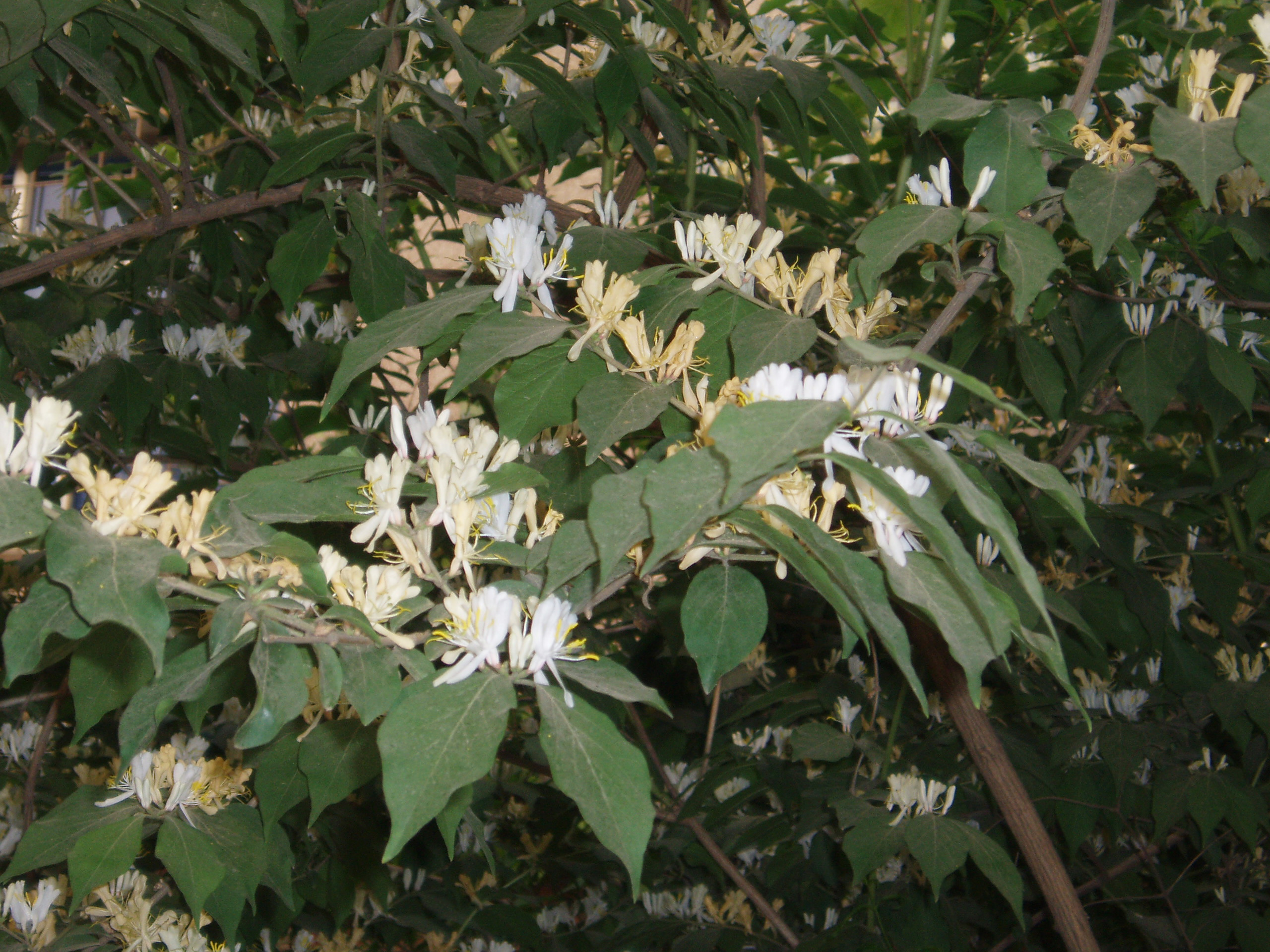- Lonicera maackii
Taxobox
name = "Lonicera maackii"

image_width = 240px
image_caption = Foliage and flowers in spring
regnum =Plant ae
divisio = Magnoliophyta
classis = Magnoliopsida
ordo =Dipsacales
familia =Caprifoliaceae
genus = "Lonicera "
species = "L. maackii"
binomial = "Lonicera maackii"
binomial_authority = (Rupr.) Maxim.
synonyms = "Xylosteon maackii" Rupr."Lonicera maackii" (Amur Honeysuckle or Bush Honeysuckle) is a species of
honeysuckle in the familyCaprifoliaceae , native to temperateAsia in northern and westernChina (south toYunnan ),Mongolia ,Japan (central and northernHonshū , rare),Korea , and southeasternRussia (Primorsky Krai ).Germplasm Resources Information Network: [http://www.ars-grin.gov/cgi-bin/npgs/html/taxon.pl?22596 "Lonicera maackii"] ] It is listed as anendangered species in Japan.Ministry of the Environment (Japan): [http://www.biodic.go.jp/english/rdb/red_plants.csv Red List of Threatened Plants of Japan (excel spreadsheet)] ] Red Data Book (Japan): [http://www.rdbplants.jp/RDB/map/sp-5/2/5281.htm "Lonicera maackii"] (in Japanese, with map; [http://translate.google.com/translate?hl=en&sl=ja&u=http://www.rdbplants.jp/RDB/map/sp-5/2/5281.htm&sa=X&oi=translate&resnum=10& google translation] )] It has escaped from cultivation and become naturalised inNew Zealand and the easternUnited States ; in theforest s of the latter, it has become an importantinvasive species .It is a
deciduous largeshrub growing to 6 m tall with stems up to 10 centimeters diameter. The leaves are oppositely arranged, 5–9 cm long and 2–4 cm broad, with an entire margin, and with at least some rough hairs on them. Theflower s are produced in pairs, commonly with several pairs grouped together in clusters; they are 2 cm long, two-lipped, white later turning yellow or light orange in colour; flowering is from mid spring to early summer.The
fruit is a bright red to black semi-translucentberry 2–6 mm diameter containing numerous smallseed s; they ripen in autumn, and are eaten bybird s, which disperse the seeds in their droppings. It is fast growing and favours shady habitats such as theforest understory , neglectedurban area s, and fence rows. It can form extremely dense thickets.Huxley, A., ed. (1992). "New RHS Dictionary of Gardening". Macmillan ISBN 0-333-47494-5.] Missouriplants: [http://www.missouriplants.com/Whiteopp/Lonicera_maackii_page.html "Lonicera maackii"] ] Invasive.org: [http://www.invasive.org/weeds/asian/lonicera.pdf "Lonicera" species (pdf file)] ]Cultivation and uses
It is grown as an
ornamental plant for its attractive flowers, and also as a hedge. A number ofcultivar s have been selected for garden use, including 'Erubescens' with pink flowers, and 'Rem Red' with erect habit.The flowers are sometimes used by
child ren, who remove the blossom by hand, and pull off the bottom to suck out the sweetnectar in the centre. The red berries are mildlypoison ous to humans and should not be eaten.As an invasive species
Spread of this plant is illegal or controlled in some areas of the United States due to its well documented invasive character. [http://www.na.fs.fed.us/fhp/invasive_plants/weeds/amur-honeysuckle.pdf USA Forest Service Weed of the Week Fact Sheet (pdf file)] ] [http://sain.utk.edu/invasives/species44.shtml Annotated Bibliography of primary research on invasive qualities of L. maackii in the USA: National Biological Information Infrastructure] ] [http://www.hort.uconn.edu/Plants/l/lonmaa/lonmaa1.html University of Connecticut Plant Database: "L. maackii"] ] [http://hcs.osu.edu/pocketgardener/source/description/lo_ackii.html Ohio State University Pocket Gardener: "L. maackii"] ] It is listed as a "invasive, banned" species in
Connecticut , "prohibited" inMassachusetts , and a "Class B noxiousweed " inVermont . [http://plants.usda.gov/java/profile?symbol=LOMA6 USDA PLANTS DATABASE: "L. maackii"] ] It is also officially listed as an invasive species by government agencies inWisconsin andTennessee .This plant is adaptable and successful in a wide range of conditions. In the United States, Amur honeysuckle was once planted to control erosion, and as hedges. It spread quickly as birds dispersed the seeds, and was soon naturalised. Notably, in deciduous forest understories of the eastern United States it forms dense growths with thick canopies that shade out native shrubs, young trees, and wild flowers. Uncontrolled, these growths create a near
monoculture of Amur Honeysuckle. This species poses a serious threat not only to the diversity of the ecosystems which they invade but also to forest regeneration itself.Honeysuckle can be controlled by cutting, flaming, or burning the plant to root level and repeating on two-week increments until nutrient reserves in the roots are depleted. To ensure eradication newly cut stumps should be treated with
herbicide . Control throughprescribed burn ing has been found to be most effective during the seed dispersal phase (late summer, early fall). Honeysuckle can also be controlled through annual applications ofglyphosate which thoroughly soak the leaves, or through grubbing of the shallowly rooted young plants. Both of these methods are only practical if high labour costs and soil damage are not of concern.Due to the invasive nature of this species and the ecological threat it possess it may be inadvisable to cultivate this plant in climates similar to those found where this species has become invasive (e.g. eastern United States). It has been suggested that existing specimens found outside of their native range in east Asia should be removed and replaced with alternative non-invasive species. Possible alternative fast growing, shade tolerant, deciduous shrubs include "
Calycanthus floridus ", "Cornus mas ", "Cornus sericea ", "Forsythia " hybrids, "Hydrangea " spp., "Syringa vulgaris ", "Viburnum cassinoides ", "Viburnum dentatum ", "Viburnum dilatatum ", "Viburnum opulus " , "Viburnum prunifolium ", "Viburnum trilobum ", "Weigela florida ".Etymology and authority
The common name Amur Honeysuckle comes from the
Amur River which is the world's eighth longestriver . This river forms the border between the Russian Far East andManchuria inChina . "L. maackii" is native to the area surrounding this river. The species name "maackii" is derived fromRichard Maack , a 19th centuryRussia n naturalist.Some
internet sources incorrectly list the species authority as (Rupr.) Herder; the correct authority is (Rupr.) Maxim.References
Wikimedia Foundation. 2010.
